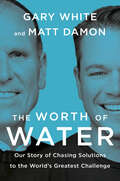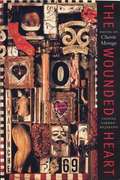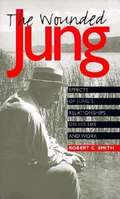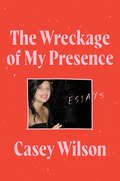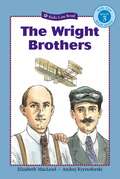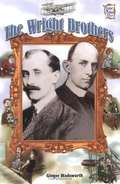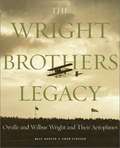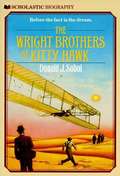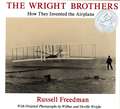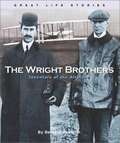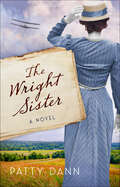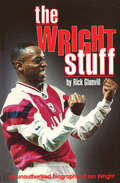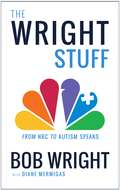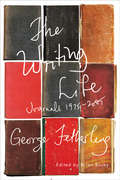- Table View
- List View
The Worth of Water: Our Story of Chasing Solutions to the World's Greatest Challenge
by Matt Damon Gary WhiteFrom the founders of nonprofits Water.org & WaterEquity Gary White and Matt Damon, the incredible true story of two unlikely allies on a mission to end the global water crisis for goodOn any given morning, you might wake up and shower with water, make your coffee with water, flush your toilet with water—and think nothing of it. But around the world, more than three-quarters of a billion people can&’t do any of that—because they have no clean water source near their homes. And 1.7 billion don&’t have access to a toilet. This crisis affects a third of the people on the planet. It keeps kids out of school and women out of work. It traps people in extreme poverty. It spreads disease. It&’s also solvable. That conviction is what brought together movie actor Matt Damon and water expert and engineer Gary White. They spent years getting the answer wrong, then halfway right, then almost right. Over time, they and their organization, Water.org, have found an approach that works. Working with partners across East Africa, Latin America, South Asia, and Southeast Asia, they&’ve helped over 40 million people access water and/or sanitation.In The Worth of Water, Gary and Matt take us along on the journey—telling stories as they uncover insights, try out new ideas, and travel between the communities they serve and the halls of power where decisions get made. With humor and humility, they illuminate the challenges of launching a brand-new model with extremely high stakes: better health and greater prosperity for people allover the world. The Worth of Water invites us to become a part of this effort—to match hope with resources, to empower families and communities, and to end the global water crisis for good. All the authors&’ proceeds from the sale of this book will be donated to Water.org.
The Wounded Heart: Writing on Cherríe Moraga
by Yvonne Yarbro-BejaranoIn her work as poet, essayist, editor, dramatist, and public intellectual, Chicana lesbian writer Cherríe Moraga has been extremely influential in current debates on culture and identity as an ongoing, open-ended process. Analyzing the "in-between" spaces in Moraga's writing where race, gender, class, and sexuality intermingle, this first book-length study of Moraga's work focuses on her writing of the body and related material practices of sex, desire, and pleasure.
The Wounded Jung: Effects of Jung's Relationships on His Life and Work
by Robert C. SmithShows how Jung's interest in the healing of the psyche was rooted in the conflicts of his own childhood. Explores his relationships with his parents, with Freud, and with the various women in his life and showing how they influenced his ideas on religion, alchemy, psychology as myth, and the reinterpretation of evil. Based on archival sources, interviews with Jung's intimates, and correspondence. For those interested in the connection between psychology and religion. Annotation c. by Book News, Inc., Portland, Or.
The Wounded Spirit
by Frank E. PerettiFrank Peretti's story of growing up with a medical condition that left him disfigured. Surgery and the miracle of prayer took care of the deformity, but not the reality of being different.
The Wreck Hunter: Battle of Britain & The Blitz
by Melody ForemanA biography of an aviation archaeology pioneer who unearthed World War II plane wrecks and the stories they contained.As long ago as 1961, Terry Parsons, then still in his twenties, began his long search for lost aircraft and memories of the Battle of Britain and the Blitz. What he discovered over the decades that followed went far beyond the tangled wreckage of military aircraft, both fighters and bombers. For with each of the thousands of RAF and Luftwaffe artifacts he unearthed came life stories of the valiant and the brave, the living and the dead.Among the items he has recovered from the many wreck sites were a mud-cloaked control column from a Spitfire with its gun button still switched to firing mode, a piece of Dornier Do 17 fuselage bearing the fatal bullet holes which led to its crash in southeast England, a pilot’s waistcoat once used to stop the drafts and rattles in a Hurricane cockpit, blood-stained maps from a Luftwaffe bomber, and a buckled tail fin from a Me 110 bearing the unmistakable symbol of the swastika.Now in this biography, created from Terry’s original notes and photographs stretching back almost seventy years, we learn not only about the historical significance of Terry’s story as a wreck-hunter but also the importance of remembering the lives of the men who fought in the skies above Britain in World War II.Indeed, this book shows us how one man’s commitment to aviation archaeology ultimately serves as a tribute to thousands of young souls both lost and found in the Battle of Britain and the Blitz.
The Wreck: A Daughter's Memoir of Becoming a Mother
by Cassandra JacksonEqual parts investigative and deeply introspective, The Wreck is a profound memoir about recognizing the echoes of history within ourselves, and the alchemy of turning inherited grief into renewal.There is a secret that young Cassandra Jackson doesn&’t know, and it&’s evident in the way her father cries her name out in his sleep. Through awkward encounters with family, she comes to realize that she is named after her father's niece, and looks eerily like the child&’s mother, both of whom were killed in a car wreck along with her father's beloved mother, and—as she soon discovers—his first wife. Cassandra learns to keep silent about the wreck, but soon learns there is no way to outpace the claw-like grip of her family&’s past trauma.In this luminous memoir, Jackson attempts to unearth her lost family, while also creating a new one--only to discover little progress separates the past from the present. As she moves back and forth between her girlhood and her journey to motherhood, Jackson reveals the chilling parallels between the harrowing inhumanity of Jim Crow medical care and the toxic discrimination that undergirds healthcare in the United States today. But as she traces the cascading effects of loss punctuated by racism, she also discovers a powerful legacy of fearless love and furious perseverance that she hopes to extend to a new generation.Lyrical, urgent, and wise, this is an unforgettable story of reclaiming the past to reclaim ourselves.
The Wreckage of My Presence: Essays
by Casey WilsonLaugh-out-loud, deeply insightful, and emotion-filled essays from multitalented actress, comedian, podcaster, and writer Casey Wilson. <P><P>Casey Wilson has a lot on her mind and she isn’t afraid to share. In this dazzling collection, each essay skillfully constructed and brimming with emotion, she shares her thoughts on the joys and vagaries of modern-day womanhood and motherhood, introduces the not-quite-typical family that made her who she is, and persuasively argues that lowbrow pop culture is the perfect lens through which to examine human nature. <P><P>Whether she’s extolling the virtues of eating in bed, processing the humiliation over her father’s late in life perm, mourning her mother's passing, or revealing her patented method for keeping the mystery alive in a marriage, Casey is witty, candid, and full of poignant and funny surprises. Humorous dives into her obsessions and areas of personal expertise—self-help, nice guys, cool girls (not her) and how to receive visitors in the bath—are matched by touching meditations on female friendship, anger, grief, motherhood, and identity. <P><P>Reading The Wreckage of My Presence is like spending time with a close friend—a deeply passionate, full-tilt, joyous, excessive, compulsive, shameless, hungry-for-it-all, loyal, cheerleading friend. A friend who is ready for any big feelings that come her way—and isn’t afraid to embrace them. <P><P><b>A New York Times Bestseller</b>
The Wrecking of La Salle's Ship Aimable and the Trial of Claude Aigron
by Robert S. WeddleWhen Robert Cavelier, sieur de La Salle, landed on the Texas coast in 1685, bent on founding a French colony, his enterprise was doomed to failure. Not only was he hundreds of miles from his intended landfall--the mouth of the Mississippi--but his supply ship, Aimable, was wrecked at the mouth of Matagorda Bay, leaving the colonists with scant provisions and little protection against local Indian tribes. In anger and disgust, he struck out at the ship's captain, Claude Aigron, accusing him of wrecking the vessel purposely and maliciously. Captain Aigron and his crew escaped the doomed colony by returning to France on the warship that had escorted the expedition on its ocean crossing. Soon after reaching France, Aigron found himself defendant in a civil suit filed by two of his officers seeking recompense for lost salary and personal effects, and then imprisoned on order of King Louis XIV while La Salle's more serious accusations were being investigated. In this book, Robert Weddle meticulously recounts, through court documents, the known history of Aigron and the Aimable, and finds that despite La Salle's fervent accusations, the facts of the case offer no clear indictment. The court documents, deftly translated by François Lagarde, reveal Captain Aigron's successful defense and illuminate the circumstances of the wreck with Aigron's testimony. Much is also revealed about the French legal system and how the sea laws of the period were applied through the French government's L'Ordonnance de la Marine.
The Wright Brothers
by David McculloughOn a winter day in 1903, in the Outer Banks of North Carolina, two unknown brothers from Ohio changed history. But it would take the world some time to believe what had happened: the age of flight had begun, with the first heavier-than-air, powered machine carrying a pilot. Who were these men and how was it that they achieved what they did? David McCullough, two-time winner of the Pulitzer Prize, tells the surprising, profoundly human story of Wilbur and Orville Wright. Far more than a couple of unschooled Dayton bicycle mechanics who happened to hit on success, they were men of exceptional courage and determination, and of far-ranging intellectual interests and ceaseless curiosity, much of which they attributed to their upbringing. The house they lived in had no electricity or indoor plumbing, but there were books aplenty, supplied mainly by their preacher father, who encouraged their studying. As individuals they had differing skill sets and passions but as a team they excelled in any given task . That they had no more than a public high school education, little money and no patron to open doors to their desires, never stopped them in their goal to take to the air. Nothing did, not even the self-evident reality that every time they took off in one of their contrivances, they risked being killed, or, at the very least, maimed. In this thrilling book, master historian David McCullough draws on the immense riches of the Wright Papers, including private diaries, notebooks, scrapbooks, and more than a thousand letters from private family correspondence to tell the human side of the Wright Brothers' story, including the little-known contributions of their sister, Katharine, without whom things might well have gone differently for them.
The Wright Brothers
by Elizabeth MacleodMeet the Wright Brothers -- inventors of the airplane. The story of how they created one of the most influential machines in history is told in level-appropriate language.
The Wright Brothers Legacy: Orville and Wilbur Wright and Their Aeroplanes
by Walt Burton Owen FindsenFrom their early experiments with gliders to the first flight of a heavier-than-air aircraft, from their tours of European and American air shows to their development of a military aircraft to the final installation of the Kitty Hawk Flyer at the Smithsonian Institution in 1948, this volume celebrates an invention that changed the world.
The Wright Brothers at Kitty Hawk
by Donald J. SobolAn account of Wright Brothers' work that led to the first flight at Kitty Hawk.
The Wright Brothers: How They Invented The Airplane
by Russell FreedmanHe saw the first regular airmail service introduced in 1918, the first nonstop transcontinental flight in 1923, the first round-the-world flight in 1924, the first polar flight in 1926, and the first nonstop flight across the Atlantic in 1927. He witnessed two world wars in which the airplane played a critical role. He saw the earth shrink as the jet engine replaced propellers. He lived to see airplanes that flew faster than the speed of sound, and planes whose wings stretched farther than the distance of his first flight at Kitty Hawk. There were moments when he looked back wistfully to those long-ago days when flying was still a dream that he shared with his brother. He once said, “I got more thrill out of flying before I had ever been in the air at all – while lying in bed thinking how exciting it would be to fly.”<P><P> Newbery Medal Honor book
The Wright Brothers: Inventors of the Airplane (Great Life Stories)
by Bernard Ryan Jr.The Wright Brothers were an amazing team who created one of the most revolutionary inventions of the twentieth century -- the airplane. Sons of a minister, Orville and Wilbur Wright were bright, industrious, and inseparable. As young men, they operated a print shop, published newspapers, and fixed and built bicycles. Orville and Wilbur began to actively pursue their dream of flying in the late 1890s. They built their first glider in 1900 and took it to Kitty Hawk, North Carolina, to test it. Three years later, Orville made the historic first flight on December 17. Their invention brought them much international attention. In 1909, they established the Wright American Company to build and sell their airplanes. Today, the Wright brothers are considered pioneers in the field of aviation. Book jacket.
The Wright Brothers: Nose-Diving into History (Epic Fails #1)
by Ben Thompson Erik SladerA hilarious nonfiction look at two of history's most epic "failures": the Wright brothers, whose countless crashes ultimately led to groundbreaking success.Although Orville and Wilbur Wright are celebrated today as heroes for their revolutionary contributions to science and engineering—they are acknowledged as the first men to successfully achieve powered, piloted flight—their success was hard-earned. (Spoiler alert: there were a lot of nosedives involved.) In fact, it took the self-taught engineers years of work and dozens of crashes before they managed a single twelve-second flight! In this first installment of the brand new Epic Fails series, Ben Thompson and Erik Slader take readers through the Wright brothers' many mishaps and misadventures as they paved the way for modern aviation. The Epic Fails series takes a humorous and unexpected view of history, exploring the surprising stories behind a variety of groundbreaking discoveries, voyages, experiments, and innovations, illustrating how many of mankind's biggest successes are in fact the result of some pretty epic failures.This title has Common Core connections.
The Wright Brothers: Pioneers of American Aviation
by Quentin ReynoldsA biography of the two brothers from Dayton, Ohio, who built and flew the first airplane.
The Wright Brothers: The Dramatic Story-behind-the-story
by David McCulloughThe #1 New York Times bestseller from David McCullough, two-time winner of the Pulitzer Prize—the dramatic story-behind-the-story about the courageous brothers who taught the world how to fly—Wilbur and Orville Wright.On a winter day in 1903, in the Outer Banks of North Carolina, two brothers—bicycle mechanics from Dayton, Ohio—changed history. But it would take the world some time to believe that the age of flight had begun, with the first powered machine carrying a pilot. Orville and Wilbur Wright were men of exceptional courage and determination, and of far-ranging intellectual interests and ceaseless curiosity. When they worked together, no problem seemed to be insurmountable. Wilbur was unquestionably a genius. Orville had such mechanical ingenuity as few had ever seen. That they had no more than a public high school education and little money never stopped them in their mission to take to the air. Nothing did, not even the self-evident reality that every time they took off, they risked being killed. In this “enjoyable, fast-paced tale” (The Economist), master historian David McCullough “shows as never before how two Ohio boys from a remarkable family taught the world to fly” (The Washington Post) and “captures the marvel of what the Wrights accomplished” (The Wall Street Journal). He draws on the extensive Wright family papers to profile not only the brothers but their sister, Katharine, without whom things might well have gone differently for them. Essential reading, this is “a story of timeless importance, told with uncommon empathy and fluency…about what might be the most astonishing feat mankind has ever accomplished…The Wright Brothers soars” (The New York Times Book Review).
The Wright Sister: A Novel
by Patty DannAn “immensely readable” novel inspired by the life of Katharine Wright and her brother Orville, a tale of estrangement and enduring love(Sally Koslow, international bestselling author of Another Side of Paradise).On December 17, 1903, Orville and Wilbur Wright flew the world’s first airplane at Kitty Hawk, North Carolina, establishing the Wright Brothers as world-renowned pioneers of flight. Known to fewer people was their whip-smart sister Katharine, a suffragette and early feminist.After Wilbur passed away, Katharine lived with and took care of her reclusive brother Orville. But when Katharine became engaged to their mutual friend, Harry Haskell, Orville felt abandoned and betrayed. He refused to attend the wedding or speak to Katharine or Harry. As the years went on, the siblings grew further and further apart.In The Wright Sister, Patty Dann wonderfully imagines the blossoming of Katharine, revealed in her “Marriage Diary”—in which she emerges as a vibrant, intellectually and socially engaged, sexually active woman coming into her own—and her one-sided correspondence with her estranged brother as she hopes to repair their relationship. Even though she pictures “Orv” throwing her letters away, Katharine cannot contain her love of married life, her strong advocacy of the suffragette cause, or her abiding affection for her stubborn sibling as she fondly recalls their shared life—in an unforgettable portrait of a woman, a sister of inventors who found a way to reinvent herself.“A marvel . . . [a] brilliant novel whose characters are now stored in my heart like favorite, absent friends.” — Elinor Lipman, author of Ms. Demeanor“Dann does an amazing job of transporting readers in time by imaging Katharine’s joy, her devotion to Orville, and the pain she feels from their one-sided correspondence.” —Booklist“No longer hidden by history, the wind beneath Wilbur and Orville’s wings—their brainy sibling Katharine—soars in The Wright Sister. [This] epistolary page-turner chronicles a woman taking flight past fifty.” — Sally Koslow, author of The Late, Lamented Molly Marx “Captures the voice of Katharine Wright with uncanny verisimilitude . . . poignant.” —Sheila Kohler, author of Once We Were Sisters
The Wright Stuff
by Rick GlanvillIan Wright is one of the English game's great football heroes. He is an England international and the leading marksman and trophy-winner for Arsenal. Yet he also regularly collects yellow cards, and is rarely out of the headlines.From humble beginnings to the heights of international stardom, this is the story of the rise of a boy from South London who has as many enemies as he has friends; of a role model who never forgot his roots; of a superstar, hungry for success, but almost denied the chance to play professional football by blatant discrimination and his own hot-headedness.
The Wright Stuff: From NBC to Autism Speaks
by Bob Wright Diane MermigasThe former CEO of NBC &“reflects on his years at the pinnacle of network television, and also on the Wrights&’ work as co-founders of Autism Speaks&” (Palm Beach Daily News). Named president and CEO of NBC at the age of 43, he faced a two-headed dragon: on one hand, distrust from the network people deeply skeptical of the &“suit&” from GE, their new corporate parent; and on the other, fiscal oversight demands from a cautious, conservative institution reluctant to invest heavily in a media business they didn&’t understand. For the next 20 years, he managed to navigate the fine line between the two and in the process completely reinvent—and save—the network. His name is Bob Wright. Under his leadership, a traditional network, struggling to survive a changing landscape, was transformed into a $45 billion cable and internet giant. What does someone like that do when he retires? If he&’s Bob Wright, he starts all over again. At almost the exact same time as Bob&’s NBC reign was winding down, his grandson Christian was diagnosed with autism, a condition then poorly understood. Baffled by a lack of medical knowledge and community support, Bob and his wife Suzanne founded Autism Speaks, which in short order became the leading advocacy and research funding organization for this mysterious condition that so devastates families. As the two story lines unfold in The Wright Stuff, readers will gradually see that both endeavors—revitalizing NBC and building Autism Speaks—reflect the same key management tenets that apply to any organization facing disruptive change. A portion of the proceeds from this book will be donated to advance autism research.
The Writer as Migrant
by Ha JinHa Jin's journey from an uneducated soldier in the People's Liberation Army in China to a resident of the United States raises questions about language, migration, and the place of literature in a globalizing world.
The Writers' Castle: Reporting History at Nuremberg
by Uwe NeumahrA gripping new approach to the Nuremberg Trial, told through the stories of the many great writers who came to witness it&“A riveting group portrait that puts these celebrity reporters in the spotlight... An engaging blend of gossipy anecdote and precise, thought-provoking analysis&” — Financial TimesNuremberg, 1945. As the trials of Nazi war criminals begin, some of the world's most famous writers and reporters gather in the ruined German city. Among them are Rebecca West, John Dos Passos, Martha Gellhorn, Erika Mann and Janet Flanner.Crammed together in the press camp at Schloss Faber-Castell, where reporters sleep ten to a room and complain about the food and argue in the lively bar, they each try to find words for the unprecedented events they are witnessing. Here, tensions simmer between Soviet and Western journalists, unlikely affairs begin, stories are falsified and fabricated—and each reporter is forever changed by what they experience.As Uwe Neumahr builds an engrossing group portrait of the literary luminaries at Nuremberg, readers are taken to the heart of the political and cultural conflicts of the time—observing history at the very moment it was being written.Providing fascinating accounts of his subjects&’ experiences at Nuremberg, Neumahr shows how those experiences marked their future lives, as well as their approaches to writing. What emerges is both a multi-faceted depiction of the trials as a unique mass-media event, but also as a public reckoning with evil that had untold private reverberations for all who witnessed it.
The Writing Life
by George Fetherling Brian BusbySelected from thousands of pages of the daily journals of George Fetherling - the inexhaustible novelist, poet, and cultural commentator - The Writing Life reveals an astute and candid observer of his contemporaries as well as himself. Hundreds of figures in the arts and public life crisscross the pages of Fetherling's journals, from Margaret Atwood and Marshall McLuhan, to Gwendolyn MacEwen and Conrad Black. The book begins in mid-1970s Toronto, a time of cultural ferment, and carries on to Vancouver and a new century. A captivating and intimate narrative, The Writing Life provides a compelling portrait of the last three decades of Canadian cultural life. From the book: Tuesday 4 February 1992 / Toronto Early this morning the latest in a series of strange phone calls from Edmund Carpenter in New York to discuss successive versions of his Canadian Notes & Queries piece on Marshall McLuhan. He falls to reminiscing and at one point says: "Marshall always reminded me of that passage in Boswell in which Boswell says that if you chanced to take shelter from a rain storm for a few minutes in Dr Johnson's company, you would come away convinced that you had just met the smartest man in the world. Marshall was like that too. Of course, if you spent an hour with Marshall, well, that was something quite different."
